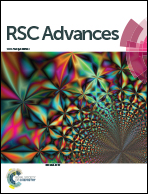Reduced graphene oxide–titania based platform for label-free biosensor†
Abstract
A label-free biosensor has been fabricated using a reduced graphene oxide (RGO) and anatase titania (ant-TiO2) nanocomposite, electrophoretically deposited onto an indium tin oxide coated glass substrate. The RGO-ant-TiO2 nanocomposite has been functionalized with protein (horseradish peroxidase) conjugated antibodies for the specific recognition and detection of Vibrio cholerae. The presence of Ab-Vc on the RGO–ant-TiO2 nanocomposite has been confirmed using electron microscopy, Fourier transform infrared spectroscopy and electrochemical techniques. Electrochemical studies relating to the fabricated Ab-Vc/RGO–ant-TiO2/ITO immunoelectrode have been conducted to investigate the binding kinetics. This immunosensor exhibits improved biosensing properties in the detection of Vibrio cholerae, with a sensitivity of 18.17 × 106 F mol−1 L−1 m−2 in the detection range of 0.12–5.4 nmol L−1, and a low detection limit of 0.12 nmol L−1. The association (ka), dissociation (kd) and equilibrium rate constants have been estimated to be 0.07 nM, 0.002 nM and 0.41 nM, respectively. This Ab-Vc/RGO–ant-TiO2/ITO immunoelectrode could be a suitable platform for the development of compact diagnostic devices.


 Please wait while we load your content...
Please wait while we load your content...